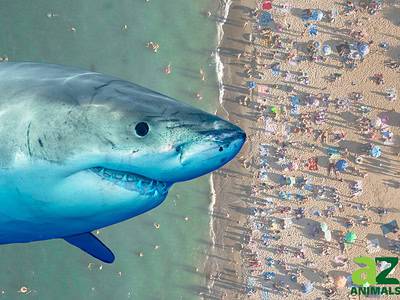Fish
Respire through the gills on their heads!
Advertisement
Fish Scientific Classification
Read our Complete Guide to Classification of Animals.
Fish Conservation Status
Fish Facts
Fish are found in every ocean, lake, river and stream in all corners of the globe, in many sizes, colours and species. Most fish (depending on size) tend to eat plankton in the water, insects and smaller fish.
Fish respire through gills in the sides of their heads, allowing the fish to breath underwater. Fish return to the water surface for air at varying intervals.
See all of our expert product reviews.
Due to the bright colours of fish, and the fact that fish are extremely peaceful animals, many people today now keep all kinds of fish in tanks and ponds.
Incredible Fish Facts
- Plenty of fish in the sea: There are more than 34,000 identified species of fish that live in nearly every underwater habitat. About the only place you won’t find fish is the deepest depths of the ocean, as no fish have been discovered at lower than 8,400 meters.
- There is still so much to learn: A 2009 report published in Science estimated the biomass of fish at between 800 to 2,000 million tonnes. For perspective, that’s between 2 to 5 times the biomass of all humans on Earth! However, a more recent study from CSIC that studied deeper ocean depths estimates the biomass of fish could be up to 10,000 million tonnes, a figure at least five times higher than previous estimates! The bottom line, we still know very little about the ecology of fish in the sea!
- Thought extinct since the dinosaurs, an ancient fish returns: There’s a species of fish known as the coelacanth that was believed to have first evolved 400 million years ago and went extinct near the end of the dinosaurs. However, in 1938 scientists made an incredible discovery, the coelacanth had survived! In 1999, a second species of coelacanth was even discovered. Once again, the discovery of a species thought extinct since the time of the dinosaurs shows how much we still have to discover about fish and the oceans!
Species of fish
With more than 34,000 species spanning fresh and saltwater, fish have incredible diversity. Below you’ll find a sampling of different orders and families of fish.
Sharks
Date back to roughly 420 million years ago. As of today there are 535 species of sharks (23 of which remain undescribed) that are split into 8 orders. Sharks span from being less than a foot long to the whale shark, which can measure more than 40 feet in length. Sharks also include apex predators like that great white shark which play important parts in ocean food chains.
Skate fish
There are more than 200 species of skate fish across the world. Skate fish are flat and closely resemble rays, but generally live in deeper ocean waters. Species of this family can grow to be more than 8 feet in length and weigh more than 200 pounds.
Salmon
There are 140 species of salmon spread across 33 genera and 6 families. Allies of salmon include whitefish, trout, pikes, and chart. Salmon reproduction occurs in freshwater, with young returning to the sea for most the remainder of their life. Salmon are an important food source across the world, with more than 70% of salmoids being important sources of food across the world.
Health and Entertainment for your Fish
See all of our expert product reviews.
Salmons very widely in size. The heaviest salmon is the Chinook salmon, which ways up to 105 pounds!
Dragonfish
Mostly deepwater fish that have at least 250 species spread out across 51 genera and 4 families. Dragonfish are abundant throughout the mid- or deepwater of the oceans. Specific species include viperfish, loose jaws, and hatchetfish.
Dragonfish vary widely in size with the largest species growing to 20 inches in length while the smallest dragonfish are just a fraction of an inch!
Lizardfish
An order of fish that evolved during the Upper Cretaceous (135 million years ago) and contains 14 families, 43 genera, and 220 species. Lizarfish are hermaphrodites that may self-fertilize and live from shallow coastal waters to the deep ocean. The largest lizard fish — the lancetfish — can grow up to 7 feet in length.
Codfish
Order includes freshwater cods, polar ads, hakes, and morbid cods. Codfish are incredibly diverse, spanning 9 families and more than 500 species! Cod are incredibly important food sources with frequently caught fish including the Alaska pollock and gadids.
The Atlantic cod is the largest codfish and can reach a total length of more than 6 1/2 feet!
Flatfish
There are about 540 flatfish spread across 117 genera and 7 families. Flatfish lay near the ocean floor and have bodies that are extremely thin. Their eyes are both on one side of their body while their jaw contorts into a sideway position.
The largest flatfish is the Atlantic halibut, which has weighed up to 697 pounds! A common flatfish for both commercial and recreational purposes is the fluke fish (or summer flounder), which can be found from Florida to Canada’s Maritime provinces.
Sucker fish
Common in streams and freshwater across America, sucker fish are a family of fish with 79 species. The fish are generally small, but certain species can weigh up to 80 pounds when fully grown. The longest-living bony freshwater fish in the world is the bigmouth buffalo, a species of suckerfish that has been recorded living up to 112 years of age!
Anglerfish
Anglerfish live near the bottom of the ocean and deepsea. Rather than using energy to hunt, anglerfish have dorsal fins that have evolved to look like “lures” that can attract fish. Once fish come near to inspect the lure, anglerfish quickly leap forth to ambush their prey.
There are more than 300 different species of anglerfish spread out across 18 families. One popular anglerfish is the monkfish, which is prized for its meat that’s been called “the poor man’s lobster.”
Explore Our Fish Pages
- Siamese fighting fish
- Puffer fish
- Scorpion fish
- Butterfly fish
- X-ray tetra
- Molly fish
- Horn shark
- Piranha
Fish FAQs (Frequently Asked Questions)
Are Fish herbivores, carnivores, or omnivores?
Fish are Omnivores, meaning they eat both plants and other animals.
What Kingdom do Fish belong to?
Fish belong to the Kingdom Animalia.
What phylum to Fish belong to?
Fish belong to the phylum Chordata.
What type of covering do Fish have?
Fish are covered in Scales.
In what type of habitat do Fish live?
Fish live in all freshwater and saltwater habitats.
What is an interesting fact about Fish?
Fish respire through the gills on their heads!
Thank you for reading! Have some feedback for us? Contact the AZ Animals editorial team.
Sources
- David Burnie, Dorling Kindersley (2011) Animal, The Definitive Visual Guide To The World's Wildlife / Accessed November 10, 2008
- Tom Jackson, Lorenz Books (2007) The World Encyclopedia Of Animals / Accessed November 10, 2008
- David Burnie, Kingfisher (2011) The Kingfisher Animal Encyclopedia / Accessed November 10, 2008
- Richard Mackay, University of California Press (2009) The Atlas Of Endangered Species / Accessed November 10, 2008
- David Burnie, Dorling Kindersley (2008) Illustrated Encyclopedia Of Animals / Accessed November 10, 2008
- Dorling Kindersley (2006) Dorling Kindersley Encyclopedia Of Animals / Accessed November 10, 2008
- PNAS / Accessed October 30, 2020
- Phys Org / Accessed October 30, 2020
- John Paxton, William Eschmeyer (1970) Encyclopedia of Fishes / Accessed October 30, 2020















